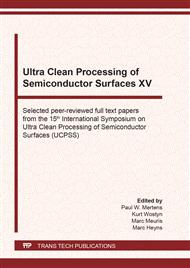p.264
p.270
p.277
p.282
p.289
p.295
p.302
p.307
p.312
Effect of Surface Chemistry on Ruthenium Wet Etching
Abstract:
Different types of ALD Ru films, including as-deposited, annealed Ru, without and with a subsequent CMP step, were used for wet etching study. With respect to the as-deposited Ru, the etching rate of the annealed Ru film in metal-free chemical mixtures (pH = 7-9) was found to decrease substantially. X-ray photoelectron spectroscopy characterization indicated that this behavior could be explained by the presence of the formation of RuOx (x = 2,3) caused by the anneal. A short CMP step applied to the annealed Ru wafer removed the surface RuOx, at least partially, resulting in a significant increase of the etching rate. The change in surface roughness was quantified using atomic force microscopy.
Info:
Periodical:
Pages:
302-306
Citation:
Online since:
February 2021
Authors:
Keywords:
Price:
Сopyright:
© 2021 Trans Tech Publications Ltd. All Rights Reserved
Share:
Citation:


